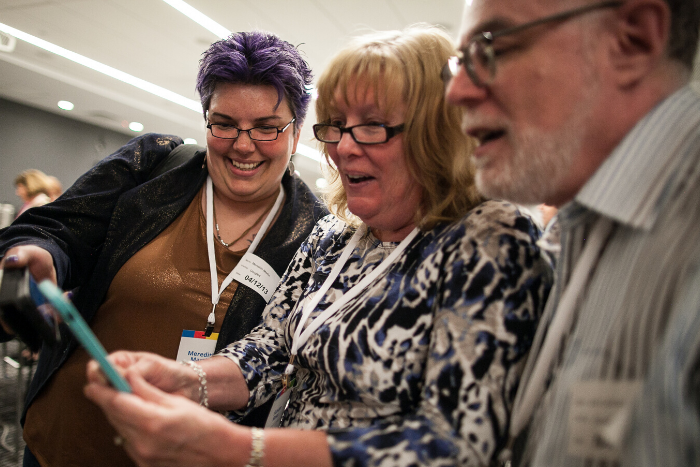When we hear the phrase “classroom incentives,” we tend to imagine students picking out treats from a prize box or receiving some other reward for good behavior. This is natural, since many of us assume that only children benefit from positive reinforcement.
However, scientific research has shown that workplace behavior — not just classroom behavior — can also improve through positive reinforcement. In essence, rewarding teachers in similar ways that we reward students can improve school and district success as a whole.
Not sure where to begin? Below, we’ve outlined four reasons why administrators should use teacher incentives in connection with a schoolwide Positive Behavioral Supports and Interventions (PBIS) program. We’ve also highlighted some great incentives you can try this school year.
Why your PBIS program should include a teacher rewards system
1. Teacher incentives give staff members something to work toward
Results from a 2019 survey published by the National Center for Education Statistics show that while a majority of teachers enjoy their jobs, two-thirds feel overworked and underappreciated. Since most school administrators are former classroom teachers, these results are not surprising. However, knowing the reasons behind it will help us to boost teacher morale.
Teaching is a unique career. Although it requires a great deal of schooling and certification, many teachers do not feel that they are as respected as those in other professional settings, such as doctors or lawyers. The fact that teachers put in many extra hours of work but are only paid a fixed salary, is one of the leading causes of high teacher turnover.
Offer rewards
Although school administrators can’t do much about the pay, they can offer other rewards that teachers can work toward when they meet or exceed goals. Choosing incentives that combat teacher burnout is another way to go the extra mile as an administrator.
These incentives may include:
- Extra breaks/planning periods for those who go the extra mile
- A Friday/Monday day off with prior approval
- Gift cards (a trip to Starbucks = self-care)
- Casual dress or flip-flop days during the week
- Having someone else cover their morning/afternoon duties
- Cover their class for one period
- Putting up their bulletin boards, copying papers, or other classroom housekeeping
- Giving them unlimited printing for a month (for schools that have a limit)

2. PBIS incentives boost teacher buy-in
Implementing an effective schoolwide PBIS program can be difficult for even the most dedicated and experienced principals. Most teachers recognize the benefits of behavior incentive programs, yet they still see them as another responsibility or chore added to their already full plates. As normal as these feelings and attitudes are, they can be the nail in the coffin for newly launched incentive programs.
Imagine a football team with players of varying abilities and attitudes toward the game. Now consider that you have just hired a head coach who enjoys parts of coaching but hates specific rules and begins to think of his position as a curse, not a blessing. What is the likelihood that a team like this would have a winning season?
How to get your teachers on board
If you want to create an atmosphere of excitement, you need to have teacher buy-in. Although you can’t force it, having the right arsenal can make it easier to get everyone on board. Here are some teacher incentives you can present to get your staff pumped about PBIS:
- Principal for the day — The teacher gets to be in charge of a decision (or decisions) usually handled by administrative staff. For example, planning when to hold a faculty meeting, selecting outfits for the next spirit day, or what teacher incentives to offer in the coming months.
- Classroom mini-grant — Donate a small amount of money toward a teacher’s classroom wish list, or buy a few items that he or she needs for a project.
- Door decoration — Decorate a teacher’s classroom door (or bulletin board) as a way of recognizing his or her dedication to PBIS. This also lifts confidence since it is a form of public recognition.
- Social media/website post — Speaking of public recognition, you can use social media like Facebook or LinkedIn to boost teacher morale. Participants in a Cicero study showed that employees produced great work when they felt they were appreciated.
- Off-campus lunch. Allow teacher teams to attend an off-campus lunch to discuss PBIS incentive ideas and ways to get students involved. Some of the best teacher incentives are those that make work feel like fun.
Keep in mind that people, even teachers, like having ownership and recognition. Allow classroom teachers to have some control over how the program works inside their room. For those that get on board (even begrudgingly), offer private and public praise — and lots of it.
3. Teacher incentives increase morale
Students want fun — and so do their teachers! Showing your staff that you are willing to invest in their happiness and work satisfaction will boost their morale. This is how schools retain their finest teachers and encourage high performance.
So, how can administrators make teaching feel good even in a high-pressure environment?
- Plan field trips for staff — Not professional development trips, but actual field trips to a coffee shop, bistro, museum, or even an arcade.
- Offer preferred parking spots — Give PBIS rock stars reserved parking for a day, week, or another designated time period. Short on parking? Give up your spot for a day!
- Give out trophies — When done often, there’s an opportunity to reward more than one teacher. Buy a trophy and designate it as the PBIS Rockstar Trophy. Each week (or month), present it to someone who is doing exceptionally well at embracing PBIS incentives.
- Invest in technology tools — . There are some great alternatives to traditional behavior management systems, such as Classcraft’s game-based program. Teachers and staff can use the platform for free or use the teacher premium license, but the schoolwide version of Classcraft comes with many tools and professional development sessions that are a great incentive for teachers struggling with student behavioral issues.
Splurge a little
Most teacher incentives in your PBIS can be free or inexpensive, but it’s OK to splurge a little when you can. Here are some tangible items or services you can buy and give out to show your appreciation:
- Candles, soap, hand sanitizer, and other small trinkets
- Candy, snacks, brownie mix, favorite coffee/tea, and other homemade treats
- Flower bouquets or green plants for the classroom
- Free car wash/detailing
- A gas card, fast-food card, or an iTunes or Netflix gift card
- Keychains, lip balm, insulated tumblers, personalized nameplates, or tote bags
- School T-shirts, sharpie sets, movie night kits, or classmate keepsake books
Think outside the box
If you have extra money to spend and want to go big, other options include:
- A tablet/iPad for the classroom
- Bose headphones
- A spa/massage day
- Teachers Pay Teachers gift card of $50 or more
- Gift card for PBIS rewards apps
- Day off with pay

4. Students win, too
When teachers are happy and meeting goals, so are their students. The only way for a positive behavior intervention program to work is to have everyone on board. Employee recognition is a huge part of that.
Research has shown that low-cost incentives can increase teacher attendance by 57% and also reduce student behavior referrals by 66%. If this is true, then rewarding teachers might be an actual intervention. Of course, the rewards themselves aren’t the focus; it’s more about the process of how you present teacher incentives.
Once you’ve chosen a few incentives to use in connection with your PBIS program, try this:
- Find a teacher doing something great and thank them.
- State exactly what they did that you appreciate and how it made you feel (this reinforces this desired behavior).
- Point out how valuable they are to the team and reward them.
- Thank them again by name.
Incentives work!
If you want to use a PBIS rewards program to influence behavior as a whole, try using your teacher incentives as an earnable prize as part of a contest. This can help build momentum over time and get more staff involved.
Although the cost of the incentives listed above varies, they are far less expensive than the cost of paying a substitute teacher or lost teaching opportunities. Incentivize your teachers to be their best selves, and they’ll come to work each day happy to make a difference.
Photo: Google Edu
MTSS - PBIS


